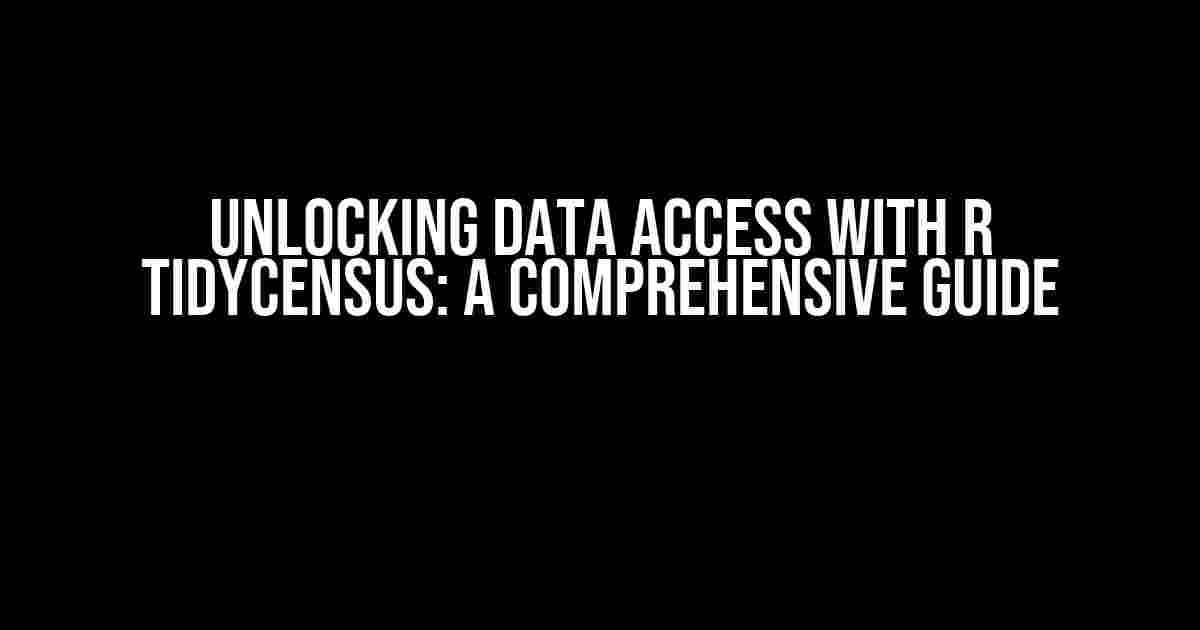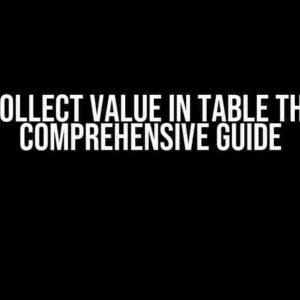As a data enthusiast or researcher, you’re likely no stranger to the world of data analysis and visualization. R tidycensus is an incredible tool that simplifies the process of accessing and working with demographic data from the US Census Bureau. But have you ever wondered, what web sites does R tidycensus use to access data? In this article, we’ll delve into the world of data sources and explore the various websites that R tidycensus relies on to provide you with accurate and up-to-date demographic data.
The Power of R tidycensus
R tidycensus is an R package that provides a convenient interface for accessing and manipulating demographic data from the US Census Bureau. With its robust functionality and user-friendly design, R tidycensus has become an essential tool for data analysts, researchers, and policymakers. But what makes R tidycensus tick? The answer lies in its ability to tap into a vast network of data sources, which we’ll explore in detail below.
Data Sources: The Backbone of R tidycensus
R tidycensus relies on a range of data sources to provide you with accurate and comprehensive demographic data. These sources include:
- The US Census Bureau’s API, which provides access to a vast repository of demographic data, including the Decennial Census, American Community Survey (ACS), and more.
- The American Community Survey (ACS) FTP site, which offers bulk access to ACS data in various formats.
- The Census Bureau’s Population Estimates Program (PEP), which provides estimates of population, housing units, and components of change for states, counties, and metropolitan areas.
- The Bureau of Labor Statistics (BLS) Local Area Unemployment Statistics (LAUS) program, which offers data on employment, unemployment, and labor force for states, counties, and metropolitan areas.
- The USDA’s Economic Research Service (ERS) County Typology Codes, which provides a classification system for counties based on economic and social characteristics.
How R tidycensus Accesses Data
Now that we’ve explored the data sources that R tidycensus relies on, let’s dive deeper into the mechanics of how it accesses this data. R tidycensus uses a combination of APIs, FTP sites, and data repositories to gather data from these sources. Here’s a step-by-step breakdown of the process:
tidycensus()function: When you call thetidycensus()function, R tidycensus sends a request to the specified data source (e.g., the US Census Bureau’s API or the ACS FTP site).- Data retrieval: The data source responds with the requested data, which is then parsed and cleaned by R tidycensus.
- Data processing: R tidycensus applies any necessary transformations, aggregations, or calculations to the data, depending on the specific function or request.
- Data return: The processed data is then returned to you in a tidy, analysis-ready format.
A Deep Dive into the US Census Bureau’s API
The US Census Bureau’s API is a crucial component of R tidycensus, providing access to a vast repository of demographic data. Let’s take a closer look at how R tidycensus interacts with this API:
library(tidycensus)
# Load the tidycensus package
tidycensus_api_key <- "YOUR_API_KEY"
# Set your API key
data <- get_decennial(2020, "AL", variables = c("P001001", "P002001"))
# Request decennial census data for Alabama, 2020, with variables P001001 and P002001
print(data)
# Print the resulting data frame
In this example, R tidycensus sends a request to the US Census Bureau's API, specifying the desired data, variables, and API key. The API responds with the requested data, which is then parsed and cleaned by R tidycensus before being returned to you in a tidy data frame.
Conclusion
R tidycensus is an incredibly powerful tool for accessing and working with demographic data from the US Census Bureau. By understanding the data sources and mechanisms that power R tidycensus, you can unlock the full potential of this package and take your data analysis to the next level. Whether you're a seasoned researcher or just starting out, R tidycensus is an essential tool for anyone working with demographic data.
In this article, we've explored the various websites that R tidycensus uses to access data, including the US Census Bureau's API, the ACS FTP site, and more. We've also delved into the mechanics of how R tidycensus interacts with these data sources, providing a step-by-step breakdown of the process.
By mastering R tidycensus and its data sources, you'll be well on your way to unlocking the secrets of demographic data. So why wait? Dive in and start exploring the world of R tidycensus today!
| Data Source | Description |
|---|---|
| Provides access to a vast repository of demographic data, including the Decennial Census, American Community Survey (ACS), and more. | |
| ACS FTP site | Offers bulk access to ACS data in various formats. |
| Census Bureau's Population Estimates Program (PEP) | Provides estimates of population, housing units, and components of change for states, counties, and metropolitan areas. |
| Bureau of Labor Statistics (BLS) Local Area Unemployment Statistics (LAUS) program | Offers data on employment, unemployment, and labor force for states, counties, and metropolitan areas. |
| USDA's Economic Research Service (ERS) County Typology Codes | Provides a classification system for counties based on economic and social characteristics. |
Frequently Asked Question
Curious about the web sites that R tidycensus uses to access data? We've got you covered!
What is the primary source of data for tidycensus?
The primary source of data for tidycensus is the United States Census Bureau's API. tidycensus uses this API to access a vast range of demographic and economic data, including data from the Decennial Census, American Community Survey (ACS), and more.
Does tidycensus use data from other government agencies?
Yes, tidycensus also uses data from other government agencies, such as the Bureau of Labor Statistics (BLS), the National Center for Education Statistics (NCES), and the Centers for Disease Control and Prevention (CDC). These agencies provide valuable data on topics like employment, education, and health.
Are there any non-governmental sources of data used by tidycensus?
Yes, tidycensus also uses data from non-governmental sources, such as the Environmental Protection Agency's (EPA) Environmental Justice Screening and Mapping Tool and the US Department of Agriculture's (USDA) Economic Research Service. These sources provide valuable insights into environmental and agricultural topics.
Can I access international data using tidycensus?
Currently, tidycensus is primarily focused on providing access to data from the United States. However, there are plans to expand its capabilities to include international data sources in the future.
How often is the data in tidycensus updated?
The data in tidycensus is updated regularly to reflect the latest available data from the source agencies. The frequency of updates varies depending on the data source, but tidycensus strives to provide the most up-to-date information possible.






